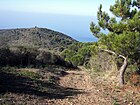Licosa | |
|---|---|
 View of the promontory and the island | |
| Coordinates: 40°15′12″N 14°54′23″E / 40.25333°N 14.90639°E | |
| Country | Italy |
| Region | |
| Province | Salerno (SA) |
| Comune | Castellabate |
| Elevation | 20 m (70 ft) |
| Population (2009)[1] | |
• Total | 82 |
| Demonym | Leucosini / Licosani |
| Time zone | UTC+1 (CET) |
| • Summer (DST) | UTC+2 (CEST) |
| Postal code | 84048 |
| Dialing code | (+39) 0974 |


Licosa is a southern Italian village and hamlet (frazione) of Castellabate, a municipality in the province of Salerno, Campania. As of 2009 its population was of 82.[1]
History
[edit]The toponym derives from the Greek word Λευκωσία (Leukosia, Lefkosía in Modern Greek), meaning "white". A legend says that Leucosia was one of the three mythological sirens met by Ulysses in the Odyssey.[2] The toponym is therefore related to Nicosia (Greek: Lefkosía, Turkish: Lefkoşa), capital of Cyprus, and to Nicosia, a town in Sicily.
The area, inhabited since the Upper Paleolithic, was settled by Oenotrians, Lucani (Leukànoi), Greeks and Romans; as witnessed by the ruins of the ancient Greek city of Leucosia, or Leukothèa. In 846 it was the site of a naval battle between the Saracens and the Duchy of Naples with allies.[3]
The medieval fief of Licosa, established by the abbot Constabilis in 1123, was part of the baronage of Castello dell'Abate, and was administered by the abbots of La Trinità della Cava.
Geography
[edit]Licosa is located in northern Cilento, by the Tyrrhenian Coast, in a rural area and forest topped by Mount Licosa (326 m). The village, composed of 3 sections named Licosa I, Licosa II and Licosa III,[4] lies nearby a cape named Punta Licosa.[5] In front of the cape, that counts a little harbor, is located the Isola Licosa (Licosa Island),[6] an islet that hosts a lighthouse.
The village, located between San Marco (3 km north) and Ogliastro Marina (4 km south), is 6 km far from Santa Maria, 7 from Castellabate, 8 from Case del Conte, 19 from Agropoli and 73 from Salerno.
Natural environment
[edit]Licosa's territory belongs to the National Park of Cilento and its coastline, characterized by the flysch rocks, is part of the marine protected area of Santa Maria di Castellabate.[7] The territory, far from urban settlements, is surrounded by maquis shrubland (macchia) and forest.
Gallery
[edit]-
Palace Granito, nearby the island
-
View of Mount Licosa trail to the coastal tower Semaforo
-
The flysch by the coast
See also
[edit]References
[edit]- ^ a b (in Italian) Licosa (section I, section II and section III) at italia.indettaglio.it
- ^ "The Siren Leucosia" on cilentodamare.it
- ^ "The Saracen Raid of Rome in 846 – An example of maritime ghazw. (pp. 93–120)" (Academia.edu)
- ^ (in Italian) Source: Istat 2001
- ^ 1314897084 Licosa on OpenStreetMap
- ^ 122364454 Isola Licosa on OpenStreetMap
- ^ (in Italian) Marine Protected Area of Santa Maria di Castellabate (parks.it)
External links
[edit]![]() Media related to Licosa at Wikimedia Commons
Media related to Licosa at Wikimedia Commons












